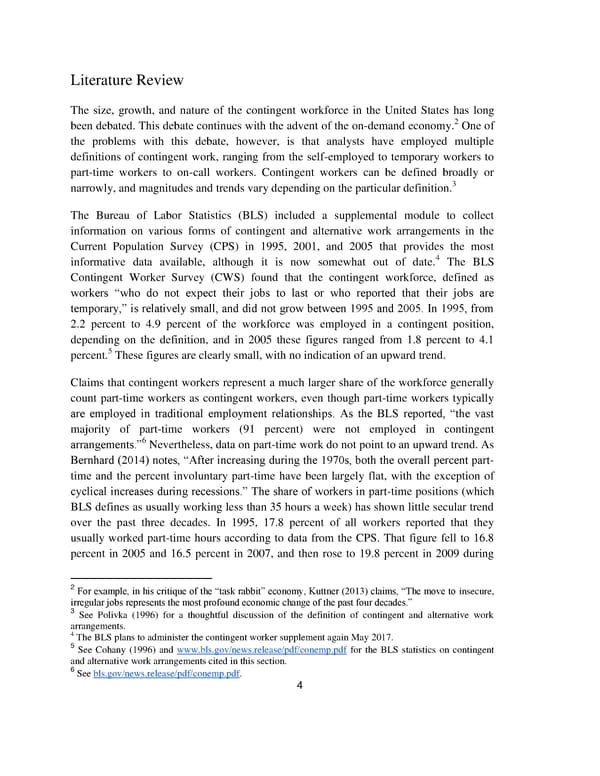Literature Review The size, growth, and nature of the contingent workforce in the United States has long been debated. This debate continues with the advent of the on-demand economy.2 One of the problems with this debate, however, is that analysts have employed multiple definitions of contingent work, ranging from the self-employed to temporary workers to part-time workers to on-call workers. Contingent workers can be defined broadly or narrowly, and magnitudes and trends vary depending on the particular definition.3 The Bureau of Labor Statistics (BLS) included a supplemental module to collect information on various forms of contingent and alternative work arrangements in the Current Population Survey (CPS) in 1995, 2001, and 2005 that provides the most informative data available, although it is now somewhat out of date.4 The BLS Contingent Worker Survey (CWS) found that the contingent workforce, defined as workers “who do not expect their jobs to last or who reported that their jobs are temporary,” is relatively small, and did not grow between 1995 and 2005. In 1995, from 2.2 percent to 4.9 percent of the workforce was employed in a contingent position, depending on the definition, and in 2005 these figures ranged from 1.8 percent to 4.1 percent.5 These figures are clearly small, with no indication of an upward trend. Claims that contingent workers represent a much larger share of the workforce generally count part-time workers as contingent workers, even though part-time workers typically are employed in traditional employment relationships. As the BLS reported, “the vast majority of part-time workers (91 percent) were not employed in contingent arrangements.”6 Nevertheless, data on part-time work do not point to an upward trend. As Bernhard (2014) notes, “After increasing during the 1970s, both the overall percent part- time and the percent involuntary part-time have been largely flat, with the exception of cyclical increases during recessions.” The share of workers in part-time positions (which BLS defines as usually working less than 35 hours a week) has shown little secular trend over the past three decades. In 1995, 17.8 percent of all workers reported that they usually worked part-time hours according to data from the CPS. That figure fell to 16.8 percent in 2005 and 16.5 percent in 2007, and then rose to 19.8 percent in 2009 during 2 For example, in his critique of the “task rabbit” economy, Kuttner (2013) claims, “The move to insecure, irregular jobs represents the most profound economic change of the past four decades.” 3 See Polivka (1996) for a thoughtful discussion of the definition of contingent and alternative work arrangements. 4 The BLS plans to administer the contingent worker supplement again May 2017. 5 See Cohany (1996) and www.bls.gov/news.release/pdf/conemp.pdf for the BLS statistics on contingent and alternative work arrangements cited in this section. 6 See bls.gov/news.release/pdf/conemp.pdf. 4
 An Analysis Of The Labor Market For Uber’s Driver-partners In The United States Page 4 Page 6
An Analysis Of The Labor Market For Uber’s Driver-partners In The United States Page 4 Page 6